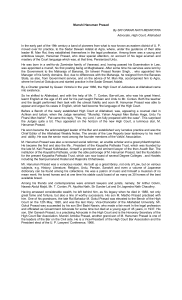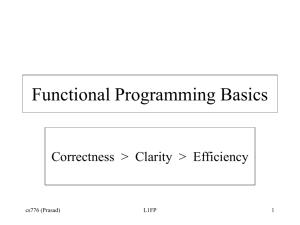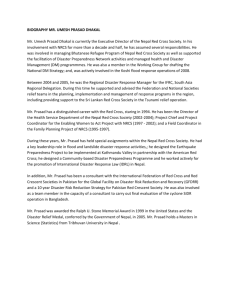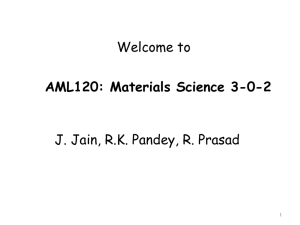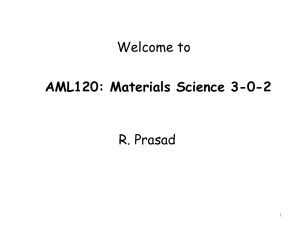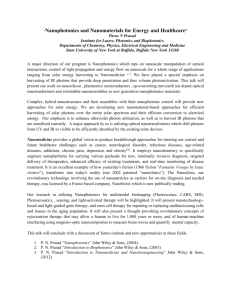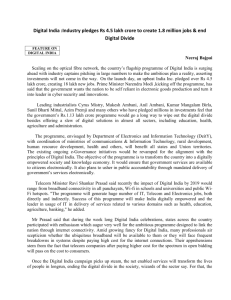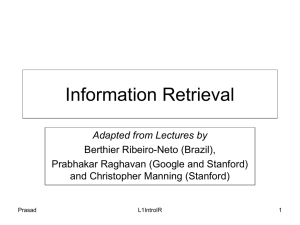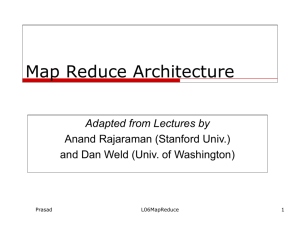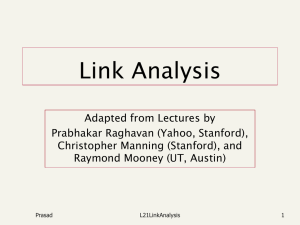Levels of Abstraction
advertisement
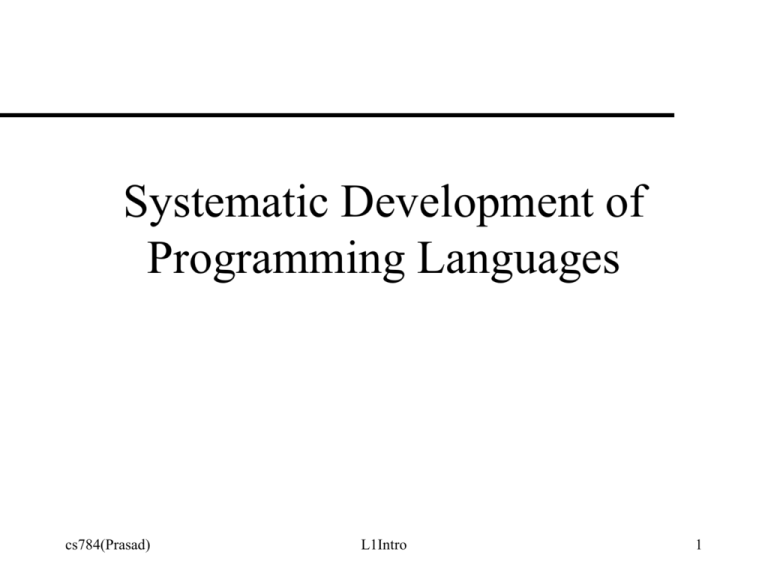
Systematic Development of
Programming Languages
cs784(Prasad)
L1Intro
1
Orthogonal Parameters
Conceptual
view (Model of Computation)
» imperative, functional, relational,...
Level
of abstraction (Model of Implementation)
» problem domain
» ...
» machine
– Computational Task : I/O relation to be
implemented
cs784(Prasad)
L1Intro
2
1. Customized Digital Computer
Task j
Ij
Oj
Task k
Ik
Ok
Rig different circuit for each task
cs784(Prasad)
L1Intro
3
2. Stored Program Computing
von
Neumann showed the existence of a
Universal Machine (hardware) that can be
customized using control inputs to carry out
different tasks.
Software is the encoding of the task to control
this machine.
encoding(Tj)
Ij
cs784(Prasad)
Oj
L1Intro
4
Imperative Languages
Model
of Computation
» ALU + Memory + Input + Output
(von Neumann architecture)
Levels
of Abstraction (“Human Interface”)
– Machine Language
» Binary Representation of the task
– Assembly Language
» Symbolic Representation of the task
cs784(Prasad)
L1Intro
5
Assembly Language
ADDI R4,R2,21
ADDI R4
R2
21
10101100100000100000000000010101
Use
symbols instead of binary digits to
describe fields of instructions.
Every aspect of machine visible in program:
– One statement per machine instruction.
– Register allocation, call stack, etc. must be
managed explicitly.
No
structure: everything looks the same.
Pros and Cons of Assembly Language
Avoids Absolute Addressing
» relocatable, reusable/shareable
Uses Symbolic
» readable
Names
Low-level programming wastes effort in
coding a solution rather than solving a
problem.
Difficult
cs784(Prasad)
to build and maintain large programs.
L1Intro
7
High-level Language
Provides
notation to describe problem
solving strategies rather than organize data
and instructions at machine-level.
Improves programmer productivity by
supporting features to abstract/reuse
code, and to improve reliability/robustness
of programs.
Requires a compiler.
cs784(Prasad)
L1Intro
8
Levels of Abstraction
Problem Domain (stacks, tables)
(Class Hierarchies)
Java/C#/Scala/Python/Scheme
C++
Ada
(ADTs)
C
Pascal (arrays)
Assembly Language
Machine (char, int)
cs784(Prasad)
L1Intro
9
Evolution of Programming Languages
• FORTRAN ( FORmula TRANslator)
Goals :
Scientific Computations
Efficiency of execution
Compile-time storage determination
Features : Symbolic Expressions
Subprograms
Absence of Recursion
• COBOL
Goal:
Business Application
Features : Record/Structure; File Handling
cs784(Prasad)
L1Intro
10
Evolution of Programming Languages
• ALGOL - 60 (ALGOrithmic Language)
Goals :
Communicating Algorithms
Features : Block Structure (Top-down design)
Recursion (Problem-solving strategy)
BNF - Specification
• LISP (LISt Processing)
Goals :
Manipulating symbolic information
Features : List Primitives
Interpreters / Environment
cs784(Prasad)
L1Intro
11
Problems
Not
rugged wrt typographical errors
Do 10 I = 1.20
vs
Do 10 I = 1,20
I5 = I5 + 1
vs
I5 = IK + 1
– Remedy: Declare before use
Unintended
Coercion
I > J and false
– Remedy: Type checking
cs784(Prasad)
L1Intro
12
Evolution of Programming Languages
• Pascal
Goal : Structured Programming, Type checking,
Compiler writing.
Features :
• Rich set of data types for efficient
algorithm design
• E.g., Records, sets, ...
• Variety of “readable” single-entry
single-exit control structures
• E.g., for-loop, while-loop,...
• Efficient Implementation
• Recursive descent parsing
cs784(Prasad)
L1Intro
13
Programming in the Large
Programs
no longer monolithic. Developed
by a team of programmers.
Code sharing and reuse very important.
Correctness, reliability, and robustness
essential.
– Data Abstraction / Encapsulation / Strong
Typing
» Ada, CLU, Modula etc.
cs784(Prasad)
L1Intro
14
Other Languages
Functional
» Common LISP, Scheme
» ML, Haskell
Logic
» Prolog
Object-oriented
» Smalltalk, SIMULA, Modula-3, Oberon
» C++, Java, C#, Eiffel, Ada-95
Hybrid
» Python, Ruby, Scala
Application
cs784(Prasad)
specific languages and tools
L1Intro
15
Scripting vs Systems Programming Languages
Designed for gluing
applications : flexibility
Interpreted
Dynamic typing and
variable creation
Data and code integrated :
meta-programming
supported
Examples: PERL, Tcl,
Python, Ruby, PHP,
Scheme, Visual Basic,
Scala, etc.
cs784(Prasad)
L1Intro
Designed for building
applications : efficiency
Compiled
Static typing and variable
declaration
Data and code separated :
cannot create/run code on
the fly
Examples: PL/1, Ada,
Java, C, C++, C#, Scala,
etc.
16
(cont’d)
Does application implement complex algorithms and data
structures?
Does application process large data sets (>10,000 items)?
Are application functions well-defined, fixed?
If yes, consider a system programming language.
Is the main task to connect components, legacy apps?
Does the application manipulate a variety of things?
Does the application have a GUI?
Are the application's functions evolving rapidly?
Must the application be extensible?
Does the application do a lot of string manipulation?
If yes, consider a scripting language.
cs784(Prasad)
L1Intro
17
Jython (for convenient access to Java APIs)
I:\tkprasad\cs784>jython
Jython 2.1 on java1.4.1_02 (JIT: null)
Type "copyright", "credits" or "license" for more information.
>>> import javax.swing as swing
>>> win = swing.JFrame("Welcome to Jython")
>>> win.size = (200, 200)
>>> win.show()
>>> ^Z
cs784(Prasad)
L1Intro
18
Java vs Jython
map = new HashMap();
map.put("one",new Integer(1));
map.put("two",new Integer(2));
map.put("three",new Integer(3));
map =
{"one":1,"two":2,"three":3}
System.out.println(map.get("one"));
print map ["one"]
list = new LinkedList();
list.add(new Integer(1));
list.add(new Integer(2));
list.add(new Integer(3));
cs784(Prasad)
list = [1, 2, 3]
L1Intro
19
(cont’d)
for (Iterator i; i.hasNext();)
{
i.next();
}
for i in list:
(* iterator *)
List newList = ArrayList()
for (Iterator i; i.hasNext();)
{
Object obj = i.next();
newList.add(function(obj))
}
cs784(Prasad)
L1Intro
newList =
[function(i) for i in oldList]
(* list comprehension *)
20
Functional Programming in Jython
apply(lambda x,y : x*y, (10, 20))
# 200
map(lambda x,y: x + y, [[1,2],[“a”]], [[“3”],[“b”]])
# [[1, 2, ‘3’], [‘a’, ‘b’]]
reduce(lambda x,y: x + y, [1,2,3], 100)
# 106
filter(lambda x: x > 0, range(10,-5,-3))
# [10, 7 , 4, 1]
cs784(Prasad)
L1Intro
21
Meta-programming in Jython
Dynamic
code evaluation
print eval (“[1,3] + range(6,10,3)”)
# [1, ,3, 6, 9]
x = 2 + 3j
exec “x = 5, x + x”
#(5, (4+6j)
cs784(Prasad)
L1Intro
22
Java functionality through Jython
import java.lang as lang
import javax.swing as swing
import java.awt as awt
names = ["Groucho", "Chico", "Harpo"]
quotes = {"Groucho": "Say the secret word", "Chico": "Viaduct?",
"Harpo": "HONK!"}
def buttonPressed(event):
field.text = quotes[event.source.text]
def exit(event):
lang.System.exit(0)
def createButton(name):
return swing.JButton(name, preferredSize=(100,20),
actionPerformed=buttonPressed)
cs784(Prasad)
L1Intro
23
win = swing.JFrame("Welcome to Jython", size=(200,
200),windowClosing=exit)
win.contentPane.layout = awt.FlowLayout( )
field = swing.JTextField(preferredSize=(200,20))
win.contentPane.add(field)
buttons = [createButton(each) for each in names]
for eachButton in buttons:
win.contentPane.add(eachButton)
win.pack( )
win.show( )
cs784(Prasad)
L1Intro
24
Current Trend
Multiparadigm languages
– Functional constructs for programming in the small
» Focus on conciseness and correctness
– Object-Oriented constructs for programming in the
large
» Focus on programmer productivity and code evolution
Example languages
– Older: Python, Ruby,
– Recent: Scala, F#, etc
cs784(Prasad)
L1Intro
25
Scheme (dialect of LISP)
Recursive
definitions
Symbolic computation : List Processing
Higher-order functions
Dynamic type checking
Functional + Imperative features
Automatic storage management
– Provides a uniform executable platform for
studying, specifying, and comparing languages.
cs784(Prasad)
L1Intro
26
Standard ML and Scala
Strongly
typed language
– static type inference
– SML supports polymorphic types
Supports
Abstract Data Types and Modules
Higher-order functions
Pattern matching
– cf. Prolog, list-processing in Scheme
cs784(Prasad)
L1Intro
27
Java vs Scala
//Java - what we're used to seeing
public String buildEpochKey(String... keys) {
StringBuilder s = new StringBuilder("elem")
for(String key:keys) {
if(key != null) {
s.append(".")
s.append(key)
}
}
return s.toString(). toLowerCase()
}
cs784(Prasad)
L1Intro
28
Java vs Scala
//Scala
def buildEpochKey(keys: String*): String = {
("elem" +: keys) filter(_ != null)
mkString(".")
toLowerCase
}
cs784(Prasad)
L1Intro
29
